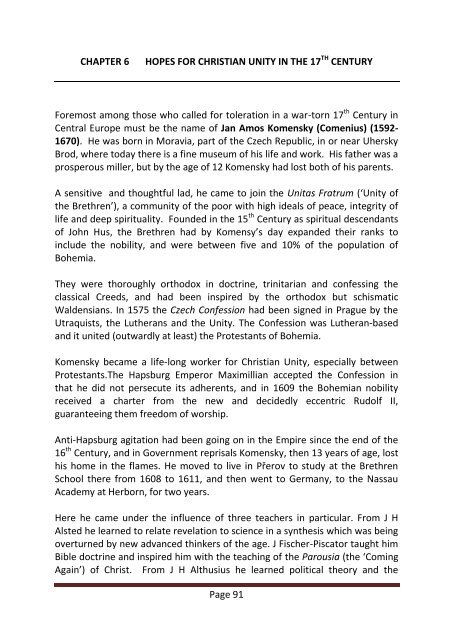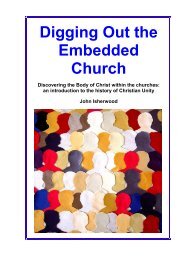Christian Unity (the book) - The Maranatha Community
Christian Unity (the book) - The Maranatha Community
Christian Unity (the book) - The Maranatha Community
Create successful ePaper yourself
Turn your PDF publications into a flip-book with our unique Google optimized e-Paper software.
CHAPTER 6HOPES FOR CHRISTIAN UNITY IN THE 17 TH CENTURYForemost among those who called for toleration in a war-torn 17 th Century inCentral Europe must be <strong>the</strong> name of Jan Amos Komensky (Comenius) (1592-1670). He was born in Moravia, part of <strong>the</strong> Czech Republic, in or near UherskyBrod, where today <strong>the</strong>re is a fine museum of his life and work. His fa<strong>the</strong>r was aprosperous miller, but by <strong>the</strong> age of 12 Komensky had lost both of his parents.A sensitive and thoughtful lad, he came to join <strong>the</strong> Unitas Fratrum (‘<strong>Unity</strong> of<strong>the</strong> Brethren’), a community of <strong>the</strong> poor with high ideals of peace, integrity oflife and deep spirituality. Founded in <strong>the</strong> 15 th Century as spiritual descendantsof John Hus, <strong>the</strong> Brethren had by Komensy’s day expanded <strong>the</strong>ir ranks toinclude <strong>the</strong> nobility, and were between five and 10% of <strong>the</strong> population ofBohemia.<strong>The</strong>y were thoroughly orthodox in doctrine, trinitarian and confessing <strong>the</strong>classical Creeds, and had been inspired by <strong>the</strong> orthodox but schismaticWaldensians. In 1575 <strong>the</strong> Czech Confession had been signed in Prague by <strong>the</strong>Utraquists, <strong>the</strong> Lu<strong>the</strong>rans and <strong>the</strong> <strong>Unity</strong>. <strong>The</strong> Confession was Lu<strong>the</strong>ran-basedand it united (outwardly at least) <strong>the</strong> Protestants of Bohemia.Komensky became a life-long worker for <strong>Christian</strong> <strong>Unity</strong>, especially betweenProtestants.<strong>The</strong> Hapsburg Emperor Maximillian accepted <strong>the</strong> Confession inthat he did not persecute its adherents, and in 1609 <strong>the</strong> Bohemian nobilityreceived a charter from <strong>the</strong> new and decidedly eccentric Rudolf II,guaranteeing <strong>the</strong>m freedom of worship.Anti-Hapsburg agitation had been going on in <strong>the</strong> Empire since <strong>the</strong> end of <strong>the</strong>16 th Century, and in Government reprisals Komensky, <strong>the</strong>n 13 years of age, losthis home in <strong>the</strong> flames. He moved to live in Přerov to study at <strong>the</strong> BrethrenSchool <strong>the</strong>re from 1608 to 1611, and <strong>the</strong>n went to Germany, to <strong>the</strong> NassauAcademy at Herborn, for two years.Here he came under <strong>the</strong> influence of three teachers in particular. From J HAlsted he learned to relate revelation to science in a syn<strong>the</strong>sis which was beingoverturned by new advanced thinkers of <strong>the</strong> age. J Fischer-Piscator taught himBible doctrine and inspired him with <strong>the</strong> teaching of <strong>the</strong> Parousia (<strong>the</strong> ‘ComingAgain’) of Christ. From J H Althusius he learned political <strong>the</strong>ory and <strong>the</strong>Page 91








